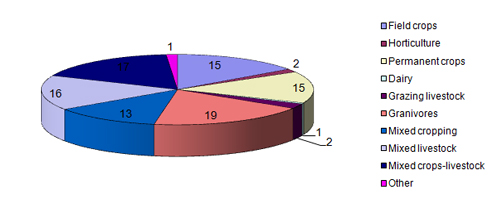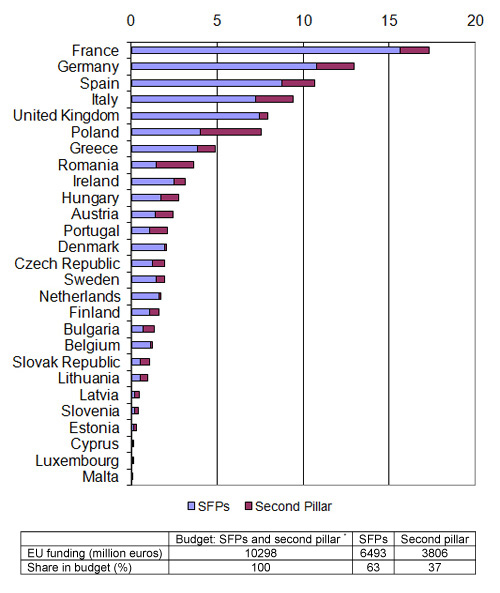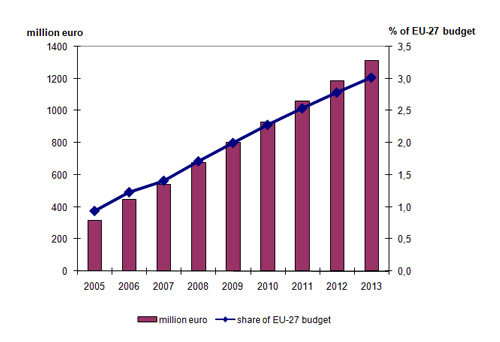Hungary
• General country description
• A. First pillar: implementation of CAP reforms (2003)
• B. Second pillar: implementation of RDP measures during 2007-2013
• C. Vision for the CAP beyond 2013: a short overview of the debate (at Member State level) on future CAP reform
• D. Literature, sources, references
• The comparative analysis provides a compact overview of CAP implementation across all 27 Member States and their visions of the future of the CAP
General country discription
Hungary* |
Comparison with EU-25 |
Population, 2005 (*1,000,000): 10.1 |
2.2% of population in EU-25 |
Population density, 2003 (inh./km2): 109 |
118 in EU-25 |
GDP/capita, 2005 (PPS): 14,500 |
62% of GDP/capita in EU-25 |
Share agriculture in total employment, 2002 (%): 7 |
5% in EU-25 |
Share Utilized Agricultural Area in total land area, 2003 (%): 65 |
46% in EU-25 in 1998 |
Average farm size, 2005 (ha): 26 |
19 in EU-15 |
Number of farms, 2005 (*1000): 155.4 |
2.4% of farms in EU-25 |
* The Eurostat-figures differ from the national statistics. As to agricultural figures these differences are considerable due to other definitions of farm and types of farms. The average farm size is according to Hungarian national statistics (2006) 3,5 ha. The number of agricultural enterprises is 7900 and the number of private farms is 707.000. 48% of the farmers produce for the market. Furthermore, the distribution of farm types differ considerable. According to the Hungarian statistics 24% of the farms are arable, 12% permanent crops, 1,41 % horticulture, 0,45 % dairy cattle, 0,1 % beef and mixed cattle, 2% sheep and goats, 5,3 % pigs, 4,45% poultry and mixed granivores, 15,2 mixed livestock, 12,7 mixed cropping, 17,1% crop and livestock. These figures considers 714 792 agricultural enterprises and private farms. Source: Agriculture in Hungary - Farm Typology published by Hungarian Central Statistical Office.
Distribution of farming types, 2005 (% of total)

Source: own calculations based on Eurostat
EU funding for the Single Payment Scheme (SPS)
and the second pillar, 2007-2013

* Funding according to CAP budget including Bulgaria and Romania. Sources: Agra Europe (2007); CEU (2006); EC (2007a)
A. First pillar: implementation CAP reform (2003)
A.1 Single Payment Scheme
Model
Implementation in 2009. SAPS (EC, 2007)
Coupling measures
seperate sugar payments (EC, 2007)
Reason for selection
no information
A.2 EU budget for Single Payment Scheme (SPS) per year (National ceiling) 2005-2013

Source: 2005: EC (2006); 2006-2013: CEU (2006) and Agra Europe (2007)
Tradability of SPS
No information
A.3 Cross-compliance: Good Agricultural and Environmental Conditions (GAEC)
Source: IEEP, 2005
Selected standards of the GAEC
Issue |
Standards |
Summary of farmers’ obligations |
Soil erosion |
minimum soil cover |
before spring sown crops if vulnarable for erosion |
|
minimum land management reflecting site-specific conditions |
countour tillage; row crops on slopes >12%; preserve uncultivated greenspaces |
|
retain terraces |
|
soil organic matter |
arable stubble management |
stubble ploughing, no burning |
soil structure |
appropriate machinery use |
periodical deep tillage, number of operations on land as function of humidity of the soil |
protection of permanent pastures |
|
If pp decreases 10%, re-establishment of PP that has been converted to arable land is obligatory. |
minimum level of maintenance |
minimum livestock stocking rates or/and appropriate regimes |
at least one clearing mowing per year. Grazing and mowing regimes accordingly to grassland types |
|
retention of landscape features |
|
|
avoiding the encroachment of unwanted vegetation on agricultural land |
herbs or ligneous plants |
|
EXTRA: agricultural land no longer in use |
keep land tilled, ensure weed free status |
Source: § Act 156/1994 issued by the Hungarian Ministry for Agriculture and Landscape management
Hungary pays attention to all issues of GAEC with several environmental standards.
Reason for selection of cross compliance standards
No information.
A.4 Further reform of market regulations
No information
B. Second pillar: implementation of RDP measures 2007-2013
B.1 Programme level and approval
There is one national RDP. The Rural Development Committee (consisting of representatives of the 27 Member States) has approved the RDP for Hungary on 20 September 2007.
B.2 Distribution of public budget over the axes (%) 1)
axis 1: competitiveness |
axis 2: environment and land management |
axis 3: rural economy |
Axis 4: Leader |
48 |
32 |
14 |
5 |
1) Figures excluding Technical Assistance; axis 4 will be budgeted from axis 1-3 by 25-10-65%
Source: Own calculations based on Ministry for Agriculture and Rural Development (2007)
B.3 Integration of Leader in axes 1, 2 and 3
Leader serves the realization of the objectives in Axis 1 and 2, but primarily those of Axis 3. The Leader program promotes the establishment of a number of LAGs that is larger compared to the previous program period. Axis 4 will create links among the various stakeholders of the rural economy via local communities. The objectives of Axis 3 will be present with the greatest emphasis in the Leader programme (Ministry for Agriculture and Rural Development, 2007).
B.4 Local Action Groups (LAGs)
For the period of 2007-2013, the expected number of LAGs is 70, covering at least 35% of the rural population (Ministry for Agriculture and Rural Development, 2007). In 2006, there were 72 LAGs, divided between 7 regions.*
B.5 RDP budget 2007-2013 (million euros)
total public budget |
% co-financing EAFRD1) |
EAFRD budget |
Contribution private sector |
Total costs |
National top-ups |
5159.1 |
Non-convergence regions: 52 Convergence regions: 77 |
3805.8 |
3226.1 |
8385.2 |
0 |
1) % of co-financing may vary per axis
Source: Ministry for Agriculture and Rural Development (2007)
B.6 Less Favoured Areas
In 2005, 14% of the Utilized Agricultural Area (UAA) (885,000 ha) was classified as Less Favoured Area (LFA) (CEU, 2005). According to other sources, 488,000 ha or 55% of the land was eligible for LFA payments, which differ by farm size and region.**
B.7 Drivers of RDP strategy
No information
* Information provided by Piroska Guzli, National Council in the Environment (OKT), Hungary.
** Ibid.
C. Vision on the CAP beyond 2013
No information. However, the Minister of Agriculture believes that capping of single farm payments of large farms is unfair and could cause large holdings to split up in order to avoid aid caps (Agra Europe, 2007b).
D. Literature, sources, references
- Agra Europe (2007), "Threat of SFP cuts rises as NMS accede", Agra Europe Weekly, January 12
- Agra Europe (2007b), "Commission may review Health check plans for farm aid caps", Agra Europe Weekly, November 30
- Council of the European Union (CEU) (2005), Proposal for a Council Regulation on support for rural development by the European Agricultural Fund for Rural Development (EAFRD) - redefinition of intermediate less-favoured areas, Brussels, Working Party on Agricultural Structures and Rural Development, working document (7971/05), 15 April
- Council of the European Union (CEU) (2006), Council Regulation 1782/2003 (consolidated version - August 5, 2006), Annex VIII and VIIIa, Brussels
- European Commission (EC) (2006), 35th Financial Report on the European Agricultural Guidance and Guarantee Fund, Guarantee section, 2005 Financial Year, SEC(2006)1152
- European Commission (EC) (2007a), EU support for rural development 2007-2013; Pre-allocated funding under Heading 2 "Natural Resources" of the Financial Framework, Brussels: European Commission
- European Commission (EC) (2007b), Overview of the implementation of direct payments under the CAP in Member States Version November 2007, EC, DG for Agriculture and Rural Development
- IEEP (2005), The development and implementation of cross compliance in the EU15: an analysis. Report for the RSPB, Institute for European Environmental Policy
- Ministry for Agriculture and Rural Development (2007), New Hungary Rural Development Programme 2007-2013, version 20 September 2007
